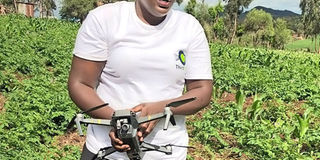Drones come in handy for pest, disease control

Veronica Mugo, a drone operator, setting up the gadget ready for work. PHOTO | COURTESY
On a windy day in the hilly Kibirichia Village, Meru County, Susan Naftali watches an eagle-sized drone hovering over her potato field.
Before drones took to the skies of Kibirichia, Ms Naftali’s one-acre farm only yielded four bags of potatoes at best, with most of the crop destroyed by late blight, a highly contagious disease that quickly spreads from one farm to the next, when spores are dispersed by wind.
For ordinary farmers in Kibirichia, Ntugi, Naare and Timau, who had no means to detect blight and pests early, crop failure was the order of the day. Efforts to come in with pesticides often proved futile, as the damage was already done; not forgetting that disease and pest detection involved moving from crop to crop, squinting anxiously at leaves for signs of infestation.
Kimani Muthomi, another farmer, recounts how he would buy pesticide after pesticide, hoping that he would chance upon one that actually worked. Not knowing which particular pesticide to buy for his problem cost him a lot of money in experiments. Then came the drones that offered early detection, allowing farmers to combat pests and disease before much harm was done.
“The drone flew over my farm and I was informed that my potatoes had late blight disease, and what would be best for control,” says Ms Naftali.
While a drone is too costly for the average smallholder farmer, the farmers do not have to worry about owning one. Courtesy of a disease surveillance project initiated by the Netherlands Development Organisation (SNV), in partnership with the Jomo Kenyatta University of Agriculture and Technology (JKUAT), and technology firm Third Eye Company, they can hire a disease surveillance drone for Sh150 an acre.

Drone hovering over a potato farm. PHOTO | COURTESY
PRODUCTIVITY
For farmers who have been hard hit by disease and pests, that Sh150 to use an unmanned aerial vehicle, could make the difference between massive crop failure and a bumper harvest.
Mounted with a near-infrared sensor (NR), the drones take high-resolution images with details that a human eye might miss.
The images are stitched into a single map, fed into a system for viewing, editing and analysis, then broken down into a format that the farmer can understand.
The farmer gets a crop advisory within three days after a drone flies over his/her farm, advising him/her which pesticides to buy and how to spray them to deal with infestation before it causes massive damage.
James Messo, the chairman of the department of soil, water and environmental engineering at JKUAT, notes that food security through enhanced farm productivity, can only be achieved through good use of water, as well as early detection of diseases and pests.
Therefore, the drone’s ability to reveal whether individual plants are water-stressed, nutritionally-deficient or under attack by insects or disease, helps enhance crop management advisory. Being able to get a 10- to 14-day early warning could prevent large-scale crop losses.
“With drones, farmers can learn of pest attacks before the infestation spreads, thus saving most of their crop,” says Dr Messo.
Moreover, ability to diagnose stress levels of plants at early stages, helps minimise pesticide use.
SNV Deputy Project Manager Abraham Mehari, adds that aside from increasing yields and lowering costs of dealing with crop damage, the technology could help attract youth to farming.
“Young people are interested in something that is not laborious and time-consuming. With drones, we can get more of them to embrace agribusiness and some to become agricultural extension officers as the job will be more attractive,” says Dr Mehari.



